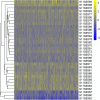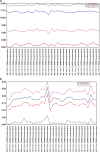Gene expression profiling in the intestinal mucosa of obese rats administered probiotic bacteria
- PMID: 29231922
- PMCID: PMC5726311
- DOI: 10.1038/sdata.2017.186
Gene expression profiling in the intestinal mucosa of obese rats administered probiotic bacteria
Abstract
We investigated whether the administration of Lactobacillus paracasei CNCM I-4034, Bifidobacterium breve CNCM I-4035 and Lactobacillus rhamnosus CNCM I-4036 modulate the expression of genes in the intestinal mucosa of obese Zucker rats. Forty-eight Zucker-Leprfa/fa and 16 Zucker lean Lepr+/fa rats were used. Eight Zucker lean Lepr+/fa and 8 Zucker-Leprfa/fa rats were euthanized as a reference. The remaining 40 Zucker-Leprfa/fa rats were then assigned to receive 1010 colony forming units (CFU) of one of the three probiotic strains, a mixture of L. paracasei CNCM I-4034 and B. breve CNCM I-4035, or a placebo by oral administration for 30 days. An additional group of 8 Zucker lean Lepr+/fa rats received the placebo for 30 days. Over 27,000 rat genes were studied using a DNA array. Four animals per group were used. Total RNA was extracted from intestinal mucosa and cDNA was synthesized, fragmented and labeled. Labeled cDNA was hybridized using GeneChip kits, and the latter were scanned. Intensity values of each probe were processed and normalized to obtain an individual value for each set of probes.
Conflict of interest statement
The authors declare no competing financial interests.
Figures





Dataset use reported in
- doi: 10.1038/s41598-017-02203-3
References
Data Citations
-
- 2016. Gene Expression Omnibus. GSE73848
References
-
- Reaven G. M. Role of insulin resistance in human disease. Diabetes 37, 1595–1607 (1988). - PubMed
-
- Reaven G. M. The metabolic syndrome or the insulin resistance syndrome? Different names, different concepts, and different goals. Endocrinol. Metab. Clin. North Am. 33, 283–303 (2004). - PubMed
-
- Lakka H. M. et al. The metabolic syndrome and total and cardiovascular disease mortality in middle-aged men. JAMA 288, 2709–2716 (2002). - PubMed
-
- Kahn R. et al. The metabolic syndrome: time for a critical appraisal: joint statement from the American Diabetes Association and the European Association for the Study of Diabetes. Diabetes Care 28, 2289–2304 (2005). - PubMed
Publication types
MeSH terms
LinkOut - more resources
Full Text Sources
Other Literature Sources
Medical
Molecular Biology Databases
Miscellaneous

